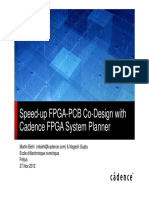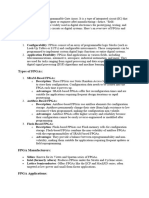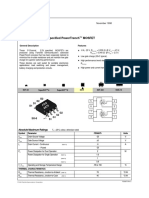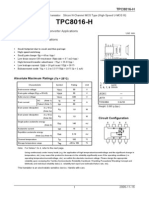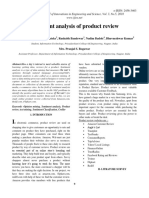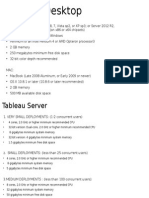PCB Fpga Ds
PCB Fpga Ds
Uploaded by
dreyes3773Copyright:
Available Formats
PCB Fpga Ds
PCB Fpga Ds
Uploaded by
dreyes3773Original Title
Copyright
Available Formats
Share this document
Did you find this document useful?
Is this content inappropriate?
Copyright:
Available Formats
PCB Fpga Ds
PCB Fpga Ds
Uploaded by
dreyes3773Copyright:
Available Formats
ALL eg R O F P G A SY steM P LaN N eR
DATASHEET
Cadence FPGA System Planner technologies are available in the following product offerings: Allegro FPGA System Planner L, XL, and GXL Allegro FPGA System Planner Two FPGA Option L Cadence OrCAD FPGA System Planner
The Cadence Allegro FPGA System Planner addresses the challenges that engineers encounter when designing one or more large-pin-count FPGAs on the PCB boardwhich includes creating the initial pin assignment, integrating with the schematic, and ensuring that the device is routable on the board. It delivers a complete, scalable technology for FPGA-PCB co-design that automates creation of optimum device-rulesaccurate pin assignment. By replacing manual, error-prone processes with automatic pin assignment synthesis, this unique placement-aware solution eliminates unnecessary physical design iterations while shortening the time required to create optimum pin assignment.
Differential User IO
Congurable
Clock Capable
Power
Figure 1: Color-coded map of the I/Os of a multi-bank FPGA with different types of congurable pins
DEsIgNINg laRgE-pINcoUNt FPGAs oN PCBs
Integrating todays FPGAswith their many different types of assignment rules and user-congurable pinson PCBs is time consuming and extends design cycles. Often the pin assignment for these FPGAs is done manually at a pin-by-pin level in an environment that is unaware of the placement of critical PCB components that are connected to FPGAs. Without understanding the impact to PCB routing, FPGA-based design projects are forced to choose between two poor options: live with suboptimal pin assignment, which can increase the number of layers on a PCB design; or deal with several unnecessary iterations at the tail end of the design cycle. Even with several iterations, this manual and error-prone approach can result in unnecessary PCB design re-spins. With the added time required to generate pin assignments for FPGAs using manual approaches, users are unable to do tradeoffs between the different FPGA devices available and the cost of devices used in an FPGA sub-system. This is because performing the trade-offs would mean that users would have to do two projects in parallel with no design reuse of any kind between the two. The Allegro FPGA System Planner provides a complete, scalable solution for FPGA-PCB co-design that allows users to create an optimum correct-byconstruction pin assignment. FPGA pin assignment is synthesized automatically based on user-specied, interface-based connectivity (design intent), as well as FPGA pin assignment rules (FPGA-rules), and actual placement of FPGAs on PCB (relative placement). With automatic pin assignment synthesis, users avoid manual error-prone processes while shortening the time to create initial pin assignment that accounts for FPGA placement on the PCB (placement-aware pin assignment synthesis). This unique placement-aware pin assignment approach eliminates unnecessary physical design iterations that are inherent in manual approaches.
With a way to quickly synthesize optimum pin assignment using user-specied design intent at a high-level, the Allegro FPGA System Planner enables designers to explore their FPGA-based architecture and to create an optimum correct-by-construction pin assignment for either production or prototype designs that use FPGAs. The Allegro FPGA System Planner is integrated with the Cadence design creation tools: Cadence OrCAD Capture and Cadence Allegro Design Entry (CIS and HDL). It reads and creates schematic symbols for both OrCAD Capture and Allegro Design Entry HDL. In addition, a oorplan view uses existing footprint libraries for OrCAD PCB Designer and Allegro PCB Editor. Should placement change during layout, pin optimization using the Allegro FPGA System Planner can be accessed directly from the Allegro PCB Editor.
Accelerates integration of FPGAs with Cadence PCB design creation environments Eliminates unnecessary, frustrating design iterations during the PCB layout process Eliminates unnecessary physical prototype iterations due to FPGA pin assignment errors Reduces PCB layer count through placement aware pin assignment and optimization
FEATURES
AllEgRo FPGA SYSTEM PLANNER TECHNOLOGY
An FPGA system is dened as a subset of the PCB design that includes one or more FPGA and non-FPGA components that are connected to FPGAs. Traditional approaches to pin assignment are typically manual and often based on a spreadsheet. Tools such as these require users to do pin assignment without taking into consideration the placement of other components and routability of the interfaces and signals. Above all, there is no online rules-checking to ensure that the right pin types are being
BENEFITS
Scalable, cost-effective FPGA-PCB co-design solution from OrCAD Capture to Allegro GXL Shortens time for optimum initial pin assignment, accelerating PCB design schedules
Figure 2: Placement/Floorplan view of the Allegro FPGA System Planner provides users relative placement of critical components for optimum pin assignment synthesis
www.cadence.com
C ade Nce ALLeg RO FPGA SY steM PLa NN eR
FPGA Vendor Tools
Allegro FPGA System Planner
Allegro Design Entry
Allegro PCB Design
denitions. Users can create interfaces such as DDR2, DDR3, and PCI Express, and use these to specify connectivity between a FPGA and a memory DIMM module or between two FPGAs. The Allegro FPGA System Planner understands differential signals, and power signals, as well as clock signals.
Allegro Part Library Symbols, Footprints
Figure 3: The Allegro FPGA System Planner uses symbols and footprints from existing libraries
FPGA DEVICE RULES
The Allegro FPGA System Planner comes with a library of device-accurate FPGA models that incorporate pin assignment rules and electrical rules specied by FPGA device vendors. These FPGA models are used by the synthesis engine to ensure that the vendor-dened electrical usage rules of the FPGAs are strictly adhered to. These rules dictate such things as clock and clock region selection, bank allocation, SSO budgeting, buffer driver utilization, I/O standard voltage reference levels,etc. During synthesis, the Allegro FPGA System Planner automatically checks hundreds of combinations of these rules to ensure that the FPGA pins are optimally and accurately utilized.
used for the signals that are assigned to the FPGA pins. As a result, users have to make several iterations between the spreadsheet-based tools and the tools from FPGA vendors. Often this adds an increased number of iterations between the PCB layout designer who cannot route the signals from FPGA pins on available layers and the FPGA designer who has to accept paper-based or verbal pin-assignment suggestions from the PCB layout designer. Once a change is made to the pin assignment by the FPGA designer, the pin assignment change has to be made in the schematic design by the hardware designer. Such iterations add several days if not weeks to the design cycle and possibly a great deal of frustration for the team members. Since this is a manual process, mistakes that are not detected can also cause expensive physical prototype iterations. While it may help to automate the synchronization of changes made to the pin assignment by the FPGA designer, hardware designer, or PCB layout designer, it doesnt reduce the root cause of these iterations. Pin assignment that is not guided by all three aspectsFPGA resource availability, FPGA vendor pin assignment rules, and routability of FPGA pins on a PCBrequires many iterations at the tail end of the design process, thereby extending the time it takes to integrate todays complex, large-pin-count FPGAs on a PCB.
SPECIFYING DESIGN INTENT
The Allegro FPGA System Planner comes with an FPGA device library to help with selection of devices to be placed. It uses OrCAD PCB Designer or Allegro PCB Editor footprints for the oorplan view and allows users to quickly create relative placement of the FPGA system components. The Allegro FPGA System Planner allows users to specify connectivity between components within the FPGA sub-system at a higher level through interface
Figure 4: The Allegro FPGA System Planner optimizes multiple FPGAs concurrently
www.cadence.com
C ade Nce ALLeg RO FPGA SY steM PLa NN eR
PLACEMENT AWARE PIN ASSIGNMENT SYNTHESIS
The Allegro FPGA System Planner provides users a way to create an FPGA system placement view using Allegro PCB footprints. Users specify connectivity between components in the placement view and the FPGA at a high level using interfaces such as DDRx, PCI Express, SATA, Front Side Bus, etc. that connect FPGAs and other components in the design, shortening the time to specify design intent for the FPGA system. Once the connectivity of the FPGA to other components in the sub-system is dened, the Allegro FPGA System Planner then synthesizes the pin assignment based on the users design intent, available FPGA resources, component placement around the FPGA, and the FPGA vendors pin assignment rules. The Allegro FPGA System Planner has a built-in DRC engine that incorporates the rules provided by FPGA vendors for pin assignment, reference voltages, and terminations. This rules-based engine prevents PCB physical prototype iterations as the FPGAs are always correctly connected.
Pin assignment algorithms are optimized to assign interface signals to a group of pins, thereby minimizing net crossovers and improving routability on the PCB.
ASIC PROTOTYPING USING FPGAs
Some companies choose to do ASIC prototyping using FPGAs on the PCB. In these cases, the number of FPGAs used grows rapidly. This sometimes requires using several PCBs to place all the FPGAs. With a large number of FPGAs, the time to do initial pin assignment can be very long using manual processes. Additionally, without taking placement of these FPGAs into account, the pin assignment can make routing of the PCB a very long process, extending the time it takes for designers to get to the ASIC prototype using FPGAs. The Allegro FPGA System Planner shortens the time required to create pin assignment for a large number of FPGAs through placement-aware pin assignment synthesis that is driven by a device-accurate FPGA models library. With the ability to export port information in Verilog and import Verilog-based connectivity, the Allegro FPGA System Planner allows users to iterate with RTL partitioning software, shortening the time to dene the FPGA-based system and quickly creating DRC-accurate FPGA pin assignment.
ARCHITECTURAL EXPLORATION ENABLED
During the device selection process, FPGA designers need a way to evaluate if the FPGA(s) they choose can meet their application needs while keeping the cost of devices as low as possible. Estimating FPGA resource requirements can be tricky and requires designers to balance Look Up Tables (LUTs), high-speed I/O requirements, and memory with I/Os for low-speed signals. Sometimes choosing more than one FPGA may be cheaper than choosing one large FPGA. While at other times choosing an FPGA with a larger pin count will sufce, thereby saving board space and routing channels. Manual pin assignment approaches make performing these cost and performance trade-offs very time consuming and tedious. With its placement-aware FPGA I/O pin assignment synthesis, the Allegro FPGA System Planner helps designers do trade-offs quickly, enabling architectural exploration that is not practical with manual approaches.
OrCAD FPGA System Planner Concurrent device optimization Placement-aware synthesis Reuse symbols and footprints Symbols & schematic generation Post-placement optimization Schematic power connections Schematic terminations 1 FPGA Yes Yes OrCAD Capture No No No
Allegro FPGA System Planner L 1 FPGA Yes Yes
Allegro FPGA System Planner Two FPGA Option 2 FPGAs Yes Yes
Allegro FPGA System Planner XL 4 FPGAs Yes Yes
Allegro FPGA System Planner GXL Unlimited FPGAs Yes Yes
Allegro Design Entry Allegro Design Entry Allegro Design Entry Allegro Design Entry CIS / Allegro Design CIS / Allegro Design CIS / Allegro Design CIS / Allegro Design Entry HDL Entry HDL Entry HDL Entry HDL Yes Yes Yes Yes Yes Yes Yes Yes Yes Yes Yes Yes
www.cadence.com
C ade Nce ALLeg RO FPGA SY steM PLa NN eR
TIGHT INTEGRATION WITH CADENCE DESIGN CREATION
The Allegro FPGA System Planner generates Allegro Design Entry CIS and Allegro Design Entry HDL schematics for the FPGA sub-system. It uses existing symbols for FPGA in Allegro Design Entry symbol libraries. If the user desires, the Allegro FPGA System Planner can create split symbols for FPGA based on the connectivity or one split symbol per bank.
hardware designer. Once the PCB layout designer starts to plan the routing of interfaces and signals on FPGA, it is possible to further rene the FPGA pin assignment based on route intent, layer constraints, and fanout chosen for the FPGA. The Allegro FPGA System Planner offers users a way to optimize FPGA pin assignment after placement and during routing of the interfaces and signals on a FPGA.
OPERATING SYSTEM SUPPORT
AllEgRo platfoRm tEchNology
Linux Windows
OrCAD tEchNology
Windows
ScalabIlIty
The Allegro FPGA System Planner technology is available in the following product offerings: Allegro FPGA System Planner GXLfor synthesizing and optimizing pin assignment of more than four FPGAs at a time. Suitable for companies that use FPGAs to prototype ASICs Allegro FPGA System Planner XLfor concurrent pin assignment, synthesis, and post-placement optimization of up to four FPGAs at a time Allegro FPGA System Planner Lfor pin assignment synthesis and post-placement optimization of a single FPGA OrCAD FPGA System Plannerfor optimum initial pin assignment synthesis of a single FPGA.
INTEGRATION WITH FPGA VENDOR TOOLS
In addition to integration with Cadence PCB design tools, the Allegro FPGA System Planner communicates seamlessly with FPGA design tools. It generates and reads supported FPGA vendors pin assignment constraint les. This capability enables the FPGA designer to evaluate pin assignments against the functional needs of the FPGA. Any changes made by the FPGA designer to account for these requirements can be imported into the Allegro FPGA System Planner so that the complete set of pin assignments remain in sync.
CADENCE SERVICES AND SUPPORT
Cadence application engineers can answer your technical questions by telephone, email, or Internet; they can also provide technical assistance and custom training. Cadence certified instructors teach more than 70 courses and bring their real-world experience into the classroom. More than 25 Internet Learning Series (iLS) online courses allow you the flexibility of training at your own computer via the Internet. SourceLink online customer support gives you answers to your technical questions24 hours a day, 7 days a weekincluding the latest in quarterly software rollups, product change release information, technical documentation, solutions, software updates, and more.
PRE-ROUTE PIN ASSIGNMENT OPTIMIZATION
The initial pin assignmentthat accounts for placement and routability of the FPGA on a PCBgoes a long way toward reducing costly design iterations between FPGA designer, PCB layout designer, and
For more information contact Cadence sales at:
+1.408.943.1234
or log on to:
www.cadence.com/ contact_us
2009 Cadence Design Systems, Inc. All rights reserved. Cadence, the Cadence logo, Allegro, OrCAD, SourceLink, and Verilog are registered trademarks of Cadence Design Systems, Inc. All others are properties of their respective holders. 20889 06/09 KM/MVC/DM/PDF
You might also like
- EGlobe G2 User's Guide Version 1.0.1.x December 2014Document158 pagesEGlobe G2 User's Guide Version 1.0.1.x December 2014George FiruțăNo ratings yet
- DSDDocument1,836 pagesDSDMia SmithNo ratings yet
- 50+ MATLAB Projects For Engineering StudentsDocument5 pages50+ MATLAB Projects For Engineering StudentsaamyaNo ratings yet
- Orcad Fpga DsDocument4 pagesOrcad Fpga Dssamarra25No ratings yet
- Asic Prototyping TPDocument11 pagesAsic Prototyping TPsarin.gaganNo ratings yet
- Fpgas and DSP: Design Alternatives For DSP SolutionsDocument8 pagesFpgas and DSP: Design Alternatives For DSP Solutionsnguyendinh126No ratings yet
- Successfully Designing FPGA-Based Systems: by Nagesh Gupta, President and CEO, Taray IncDocument7 pagesSuccessfully Designing FPGA-Based Systems: by Nagesh Gupta, President and CEO, Taray IncBlahNo ratings yet
- FPGA Based Systems:: Radha R C, Dept of ECE, BMSCEDocument24 pagesFPGA Based Systems:: Radha R C, Dept of ECE, BMSCEShachi P GowdaNo ratings yet
- Auspy DatasheetDocument2 pagesAuspy Datasheet2006ashokNo ratings yet
- Cadence Fpga Board Design FSP Intro PRESENTATIONDocument18 pagesCadence Fpga Board Design FSP Intro PRESENTATIONsamarra250% (1)
- Image Processing Using VHDLDocument36 pagesImage Processing Using VHDLthesjus raiNo ratings yet
- Fpga TutorialDocument10 pagesFpga Tutorialgsavithri_4017No ratings yet
- How To Program, Architecture, and Applications of Lattice FPGADocument23 pagesHow To Program, Architecture, and Applications of Lattice FPGAjackNo ratings yet
- Asic Prototyping TPDocument11 pagesAsic Prototyping TPLexx TwoNo ratings yet
- What Is An FPGA?Document4 pagesWhat Is An FPGA?SUNILPATRONo ratings yet
- Exploring The Differences Between Orcad vs. Allegro PCB Designers in 2023Document14 pagesExploring The Differences Between Orcad vs. Allegro PCB Designers in 2023jackNo ratings yet
- FPGA Paper PDFDocument18 pagesFPGA Paper PDFDhayanandhNo ratings yet
- Complex Programmable Logic Devices (CPLD) & Field-Programmable Gate Array (Fpga)Document29 pagesComplex Programmable Logic Devices (CPLD) & Field-Programmable Gate Array (Fpga)Prathap VuyyuruNo ratings yet
- FPGA and FPGAC (High Level Synthesise Tools)Document15 pagesFPGA and FPGAC (High Level Synthesise Tools)RUBEN DARIO TAMAYO BALLIVIANNo ratings yet
- Atul K Srivastava: 10.3 Field Programmable Gate ArraysDocument4 pagesAtul K Srivastava: 10.3 Field Programmable Gate ArraysTushar GuptaNo ratings yet
- Fpga HomeworkDocument4 pagesFpga Homeworkh68hnt1x100% (1)
- الالكترونيات الرقمية المتقدمةDocument4 pagesالالكترونيات الرقمية المتقدمةQUSI E. ABDNo ratings yet
- Digital Filters in Programmable Logic DevicesDocument13 pagesDigital Filters in Programmable Logic DevicesJoerg MenkeNo ratings yet
- Fpgas Are Programmable Semiconductor Devices That Are Based Around ADocument12 pagesFpgas Are Programmable Semiconductor Devices That Are Based Around AsaikrishnaNo ratings yet
- FPGA Vs ASICDocument9 pagesFPGA Vs ASICKamleshNo ratings yet
- Preface: Allegro® User Guide: Getting Started With Physical Design Product Version 16.6 October 2012Document7 pagesPreface: Allegro® User Guide: Getting Started With Physical Design Product Version 16.6 October 2012ArnauNo ratings yet
- Jan 08 FeatureDocument5 pagesJan 08 FeatureCarlos Andrés Moreno PetroNo ratings yet
- White Paper FPGA vs. DSP Design Reliability and Maintenance: May 2007, Ver. 1.1 1Document4 pagesWhite Paper FPGA vs. DSP Design Reliability and Maintenance: May 2007, Ver. 1.1 1Mahdi HallakNo ratings yet
- FPGA Technology XilinxDocument48 pagesFPGA Technology XilinxHossam FadeelNo ratings yet
- WP 174Document15 pagesWP 174nguyentienduy1512No ratings yet
- Fpga QuestionsDocument10 pagesFpga QuestionsSuji DarsanNo ratings yet
- Fpga Design FlowDocument3 pagesFpga Design FlowShaik IliyasNo ratings yet
- An Introduction To FPGADocument38 pagesAn Introduction To FPGADr-Eng Imad ShaheenNo ratings yet
- VHDL GuideDocument30 pagesVHDL Guidelxz5101No ratings yet
- Introduction To FPGA Technology: Top 5 Benefits: 1. What Is An FPGA?Document1 pageIntroduction To FPGA Technology: Top 5 Benefits: 1. What Is An FPGA?ferdiNo ratings yet
- Place and RouteDocument2 pagesPlace and RouteballisticanaNo ratings yet
- Is A FPGA A CPUDocument9 pagesIs A FPGA A CPUjackNo ratings yet
- Partitioning An ASICDocument6 pagesPartitioning An ASICSwtz ZraonicsNo ratings yet
- FPGA and CPLDWhat Is The DifferenceDocument10 pagesFPGA and CPLDWhat Is The DifferencejackNo ratings yet
- FPGADocument16 pagesFPGAManohar TmNo ratings yet
- What Is FPGA and Why Should You CareDocument6 pagesWhat Is FPGA and Why Should You CarejackNo ratings yet
- FPGA-Based PID Controller ImplementationDocument19 pagesFPGA-Based PID Controller Implementationchoc_ngoay1No ratings yet
- What Is Altera Quartus Used ForDocument9 pagesWhat Is Altera Quartus Used ForjackNo ratings yet
- How To Design Your Own FPGADocument8 pagesHow To Design Your Own FPGAjackNo ratings yet
- Programmable Logic CircuitsDocument40 pagesProgrammable Logic CircuitsBenita AgbagwaraNo ratings yet
- Make-SoCs-flexible-with-embedded-FPGADocument6 pagesMake-SoCs-flexible-with-embedded-FPGAALiftsNo ratings yet
- InterconnectsDocument6 pagesInterconnectsachuu1987No ratings yet
- My ExposDocument1 pageMy ExposAmine OeegaNo ratings yet
- The Cheapest FPGA Development BoardsDocument4 pagesThe Cheapest FPGA Development BoardsjackNo ratings yet
- What Is An FPGA?: Figure 1: FPGA Block StructureDocument10 pagesWhat Is An FPGA?: Figure 1: FPGA Block Structureacer551100% (1)
- Application-Specific Instruction-Set Processors (Asips) Are An Emerging Design ParadigmDocument2 pagesApplication-Specific Instruction-Set Processors (Asips) Are An Emerging Design ParadigmAjay Kumar KNo ratings yet
- Fpga QuizDocument1 pageFpga QuizFarah DurraniNo ratings yet
- Does Nvidia Use FPGA in Machine LearningDocument3 pagesDoes Nvidia Use FPGA in Machine LearningjackNo ratings yet
- How To Program Arduino FPGADocument20 pagesHow To Program Arduino FPGAjackNo ratings yet
- Difference Between FPGA and ASICDocument3 pagesDifference Between FPGA and ASICrajapbrNo ratings yet
- Implementation of DSP Algorithms On Reconfigurable Embedded PlatformDocument7 pagesImplementation of DSP Algorithms On Reconfigurable Embedded PlatformGV Avinash KumarNo ratings yet
- Definition:: Field-Programmable Gate ArrayDocument6 pagesDefinition:: Field-Programmable Gate ArrayyaduyadavendraNo ratings yet
- Unit-5 System Level Design Using Mentor Graphics EDA Tool (FPGA Advantage)Document12 pagesUnit-5 System Level Design Using Mentor Graphics EDA Tool (FPGA Advantage)kumarkankipati19No ratings yet
- Unit-1Document43 pagesUnit-1harirnair nairNo ratings yet
- 8.programmable Asic Design SoftwareDocument21 pages8.programmable Asic Design Softwaresalinsweety50% (2)
- Stepper Motor Implementation On FPGA (1) With 1.5 FinalDocument61 pagesStepper Motor Implementation On FPGA (1) With 1.5 Finalswati sakhare100% (1)
- Fpga-Asic Design Advantages-DisadvantagesDocument3 pagesFpga-Asic Design Advantages-DisadvantagesSidhoum SidNo ratings yet
- FPGA Programming for Beginners: Bring your ideas to life by creating hardware designs and electronic circuits with SystemVerilogFrom EverandFPGA Programming for Beginners: Bring your ideas to life by creating hardware designs and electronic circuits with SystemVerilogNo ratings yet
- Fds 6875Document5 pagesFds 6875dreyes3773No ratings yet
- FDMC8200SDocument12 pagesFDMC8200Sdreyes3773No ratings yet
- Dual N-Channel, Notebook Power Supply MOSFET: June 1999Document9 pagesDual N-Channel, Notebook Power Supply MOSFET: June 1999dreyes3773No ratings yet
- TPC8103Document8 pagesTPC8103dreyes3773No ratings yet
- SI9945Document4 pagesSI9945dreyes3773No ratings yet
- AO4912 Asymmetric Dual N-Channel Enhancement Mode Field Effect TransistorDocument8 pagesAO4912 Asymmetric Dual N-Channel Enhancement Mode Field Effect Transistordreyes3773No ratings yet
- AO4900 Dual N-Channel Enhancement Mode Field Effect Transistor With Schottky DiodeDocument5 pagesAO4900 Dual N-Channel Enhancement Mode Field Effect Transistor With Schottky Diodedreyes3773No ratings yet
- AO4812 Dual N-Channel Enhancement Mode Field Effect TransistorDocument4 pagesAO4812 Dual N-Channel Enhancement Mode Field Effect Transistordreyes3773No ratings yet
- Vishay Siliconix SPICE Device Model Si4362BDY N-Channel 30-V (D-S) Reduced Q, Fast Switching WFETDocument3 pagesVishay Siliconix SPICE Device Model Si4362BDY N-Channel 30-V (D-S) Reduced Q, Fast Switching WFETdreyes3773No ratings yet
- Irf7832Pbf: V R Max QGDocument10 pagesIrf7832Pbf: V R Max QGdreyes3773No ratings yet
- Si4814DY Dual N-Channel 30-V (D-S) MOSFET With Schottky DiodeDocument8 pagesSi4814DY Dual N-Channel 30-V (D-S) MOSFET With Schottky Diodedreyes3773No ratings yet
- TPC8016-H: High-Efficiency DC DC Converter Applications Notebook PC Applications Portable-Equipment ApplicationsDocument7 pagesTPC8016-H: High-Efficiency DC DC Converter Applications Notebook PC Applications Portable-Equipment Applicationsdreyes3773No ratings yet
- Si4810BDY: Vishay SiliconixDocument5 pagesSi4810BDY: Vishay Siliconixdreyes3773No ratings yet
- S T U/D3030NLS: N-Channel Logic Level E Nhancement Mode Field E Ffect TransistorDocument9 pagesS T U/D3030NLS: N-Channel Logic Level E Nhancement Mode Field E Ffect Transistordreyes3773No ratings yet
- TPC8A03-H: High Efficiency DC-DC Converter Applications Notebook PC Applications Portable Equipment ApplicationsDocument8 pagesTPC8A03-H: High Efficiency DC-DC Converter Applications Notebook PC Applications Portable Equipment Applicationsdreyes3773No ratings yet
- Si4404DY N-Channel 30-V (D-S) MOSFET: Vishay SiliconixDocument4 pagesSi4404DY N-Channel 30-V (D-S) MOSFET: Vishay Siliconixdreyes3773No ratings yet
- Rjk03B9Dpa: DatasheetDocument7 pagesRjk03B9Dpa: Datasheetdreyes3773No ratings yet
- Fdms0308Cs: N-Channel Powertrench SyncfetDocument8 pagesFdms0308Cs: N-Channel Powertrench Syncfetdreyes3773No ratings yet
- Sentiment Analysis of Product ReviewDocument6 pagesSentiment Analysis of Product ReviewInternational Journal of Innovations in Engineering and ScienceNo ratings yet
- CLL F394 TRM EngDocument10 pagesCLL F394 TRM EngMarcio MarquesNo ratings yet
- Lex and YaccDocument27 pagesLex and YaccShahid ShaikhNo ratings yet
- CBSE Class 11 Computer Science Sample Paper-02Document4 pagesCBSE Class 11 Computer Science Sample Paper-02cbsesamplepaperNo ratings yet
- Shrivastava DevSecOps What Why and HowDocument50 pagesShrivastava DevSecOps What Why and HowKalqNo ratings yet
- HCT210 Lecture Notes - Unit 3Document83 pagesHCT210 Lecture Notes - Unit 3Tawanda MahereNo ratings yet
- BIRT Report Object Model - ROMDocument60 pagesBIRT Report Object Model - ROMtoba_sayed100% (5)
- Onroad Vehical Breakdown Assistance SystemDocument51 pagesOnroad Vehical Breakdown Assistance SystemAjit KarhaleNo ratings yet
- Edi Analyst ManzargyasDocument4 pagesEdi Analyst Manzargyasyadav.vijya1No ratings yet
- Certificate in IT Syllabus: Software Development RationaleDocument4 pagesCertificate in IT Syllabus: Software Development RationaleNaziya BocusNo ratings yet
- Oultine CS 575 Computer Graphics Fall 2010Document7 pagesOultine CS 575 Computer Graphics Fall 2010Umair MüslimNo ratings yet
- GOIP Sim Server enDocument18 pagesGOIP Sim Server enCristhian UscocovichNo ratings yet
- HyperMILL 2016 2 enDocument16 pagesHyperMILL 2016 2 enPaul VeramendiNo ratings yet
- Tableau DesktopDocument2 pagesTableau DesktopPuneet GujralNo ratings yet
- SNMP Technology White PaperDocument16 pagesSNMP Technology White PaperDavid Gomez RomanoNo ratings yet
- Chapter 1 - Basic Structure of ComputersDocument33 pagesChapter 1 - Basic Structure of Computersanusrini23No ratings yet
- CTS PDFDocument54 pagesCTS PDFPILLINAGARAJUNo ratings yet
- Oracle Scripts1Document37 pagesOracle Scripts1marepallyNo ratings yet
- Linear Programming Maximization MethodDocument29 pagesLinear Programming Maximization Methodcatubig michael angeloNo ratings yet
- 2 4 3 A Plddesign Dob UnfinishedDocument3 pages2 4 3 A Plddesign Dob Unfinishedapi-287488627No ratings yet
- 3d Game Development With LWJGLDocument263 pages3d Game Development With LWJGLzbytiNo ratings yet
- Assignment 4 ActionDocument9 pagesAssignment 4 Actiongauravonnet4uNo ratings yet
- Introduction To MicroprocessorsDocument4 pagesIntroduction To MicroprocessorsNaga Chaitanya ChilukaNo ratings yet
- Mohd Aizzat Bin Mastan (BK10160339) Associate Professor Dr. Ismail Saad HK02 Electric & Electronic EngineeringDocument15 pagesMohd Aizzat Bin Mastan (BK10160339) Associate Professor Dr. Ismail Saad HK02 Electric & Electronic EngineeringBlongroupNo ratings yet
- Gs Steroids Sgiannec Foss4g2011Document77 pagesGs Steroids Sgiannec Foss4g2011alfreale744677No ratings yet
- Test Questions - JavascriptDocument81 pagesTest Questions - JavascriptMuhammad RaisNo ratings yet
- Maya MelDocument146 pagesMaya MelGurpreet Singh SohalNo ratings yet









